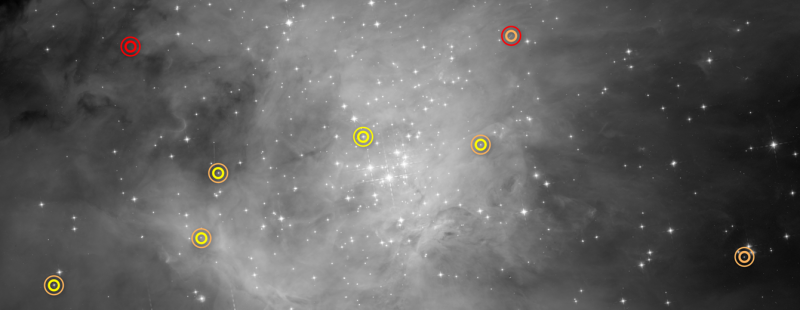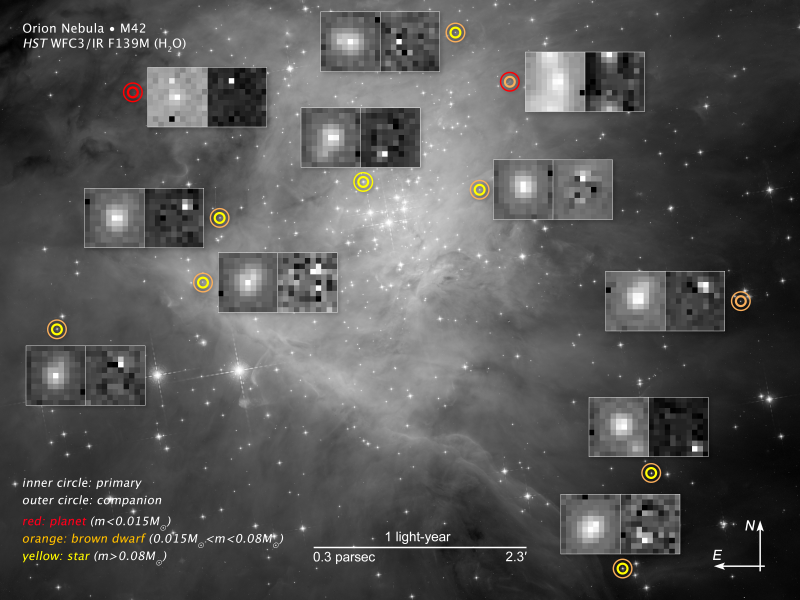
Astronomers said on January 11, 2018, that they’ve used the Hubble Space Telescope to find the largest known population of brown dwarfs sprinkled among newborn stars. And where else would this population of objects be, but the Orion Nebula, that nearby well-known star factory in space? The Orion Nebula is almost unique in our skies for being relatively nearby (only 1,350 light-years away) and extremely active in star formation. Looking in the vicinity of these stars, researchers not only found several very-low-mass brown dwarf companions, but also three giant planets. They even found an example of binary planets where two planets orbit each other in the absence of a parent star.
Brown dwarfs are very interesting, star-planet hybrids. They’re more massive than what we’d typically call a planet, but not massive enough to have enough internal pressure to spark thermonuclear fusion in their cores, and thus shine as stars do. NASA said:
Instead, brown dwarfs cool and fade as they age. Despite their low mass, brown dwarfs provide important clues to understanding how stars and planets form, and may be among the most common objects in our Milky Way galaxy.
It wasn’t long ago that we didn’t know brown dwarfs existed. Due to their faintness and coldness relative to stars, they’re still difficult to study. These astronomers used the Hubble telescope to identify brown dwarfs by the presence of water in their atmospheres. Team lead Massimo Robberto of the Space Telescope Institute in Baltimore, Maryland said in a statement from NASA:
These are so cold that water vapor forms. Water is a signature of substellar objects. It’s an amazing and very clear mark. As the masses get smaller, the stars become redder and fainter, and you need to view them in the infrared. And in infrared light, the most prominent feature is water.
But, NASA said:
… hot water vapor in the atmosphere of brown dwarfs cannot be easily seen from Earth’s surface, due to the absorbing effects of water vapor in our own atmosphere. Fortunately, Hubble is up above the atmosphere and has near-infrared vision that can easily spot water on distant worlds.
The Hubble team identified 1,200 candidate reddish stars. They found that the stars split into two distinct populations: those with water, and those without. The bright ones with water were confirmed to be faint red dwarfs. The multitude of fainter water-rich, free-floating brown dwarfs and planets within the Orion nebula are all new discoveries. Many stars without water were also detected, and these are background stars in the Milky Way. Their light was reddened by passing through interstellar dust, and therefore not relevant to the team’s study.
NASA said the team also looked for fainter, binary companions to these 1,200 reddish stars:
Because they are so close to their primary stars, these companions are nearly impossible to discover using standard observing methods. But by using a unique, high-contrast imaging technique developed by Laurent Pueyo at the Space Telescope Science Institute, astronomers were able to resolve faint images of a large number of candidate companions.
This first analysis did not allow Hubble astronomers to determine whether these objects orbit the brighter star or if their proximity in the Hubble image is a result of chance alignment. As a consequence, they are classified as candidates for now. However, the presence of water in their atmospheres indicates that most of them cannot be misaligned stars in the galactic background, and thus must be brown dwarfs or exoplanet companions.
In all, the team found 17 candidate brown dwarf companions to red dwarf stars, one brown dwarf pair, and one brown dwarf with a planetary companion. The study also identified three potential planetary mass companions: one associated to a red dwarf, one to a brown dwarf, and one to another planet. Pueyo said:
We experimented with a method, high-contrast imaging post processing, that astronomers have been relying on for years. We usually use it to look for very faint planets in the close vicinity of nearby stars, by painstakingly observing them one by one.
This time around, we decided to combine our algorithms with the ultra-stability of Hubble to inspect the vicinity of hundreds of very young stars in every single exposure obtained by the Orion survey. It turns out that even if we do not reach the deepest sensitivity for a single star, the sheer volume of our sample allowed us to obtain an unprecedented statistical snapshot of young exoplanets and brown dwarf companions in Orion.
Combining the two unique techniques, imaging in the water filters and high-contrast image processing, the survey provided an unbiased sample of newly formed low-mass sources, both dispersed in the field and companions of other low-mass objects. Massimo Robberto commented:
We could reprocess the entire Hubble archive and try to find jewels there.

Bottom line: Astronomers using the Hubble Space Telescope – looking toward the Orion Nebula – found the largest population yet of brown dwarfs and other substellar objects.











